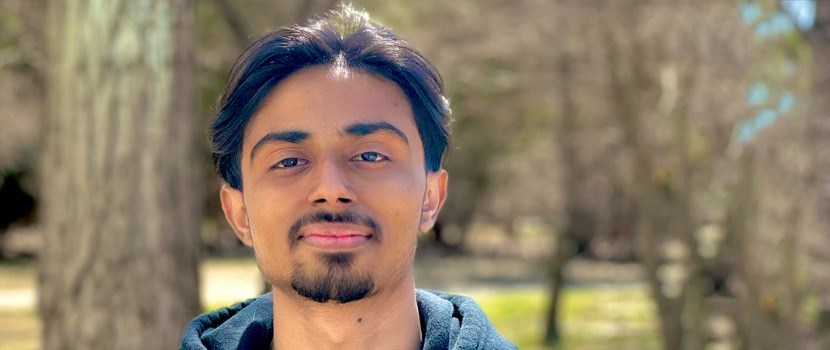SASKATCHEWAN — Rural Saskatchewan loves rain, but the people of this province also know there can be too much of a good thing. Climate change is affecting the intensity and frequency of precipitation, and some communities are learning that devastating floods can be a consequence. One such community, Foam Lake, will be a focus for Saskatchewan Polytechnic student research assistant Muhammad Abdullah over the next year.
The young researcher was recently named one of five successful applicants for a significant, $30,000 through and . The award allows him to continue and expand on work he has been doing this past year alongside Sask Polytech research chair in geospatial technologies, Dr. Abdul Raouf. While undertaking his first year of computer science at the University of Regina, Abdullah has been acting as Raouf’s student research assistant on mapping projects where digital asset management is key.
“Having a research assistant with computer science knowledge has been beneficial to my team,” says Raouf, “and the work has given Muhammad a chance to explore the practical application of his learning in ways that complement the work he is doing towards his degree.”
“Most recently I’ve been doing spectral analysis and application development for Dr. Raouf’s applied research mapping work with Frog Lake First Nation,” explains Abdullah. That project is one of a growing number of sustainability-related applied research projects Raouf and team are completing through Sask Polytech’s . “Expanding my skills in this area gave me the confidence to put forward an application for the Wawanesa Climate Champion grant. I have never done anything like this but Dr. Raouf and others on his team encouraged me to go for it.”
As an international student, Abdullah is less familiar with flooding in Saskatchewan than he is with the phenomenon in Pakistan, where he says friends and family experience it regularly. The idea for Abdullah’s grant proposal was born from discussions amongst Raouf’s team about mapping areas here in Saskatchewan vulnerable to natural and human-caused disasters for disaster evaluation and mitigation. With Raouf’s support, Abdullah proposed improving the accuracy of flood zone mapping, using Foam Lake as a test case. The Saskatchewan Water Security Agency (WSA) identified the town as one of 20 critical communities prone to flooding and in dire need of flood zone maps. The proposed project will leverage machine learning and augmented/virtual reality (mixed reality or MR) techniques to create accurate flood zone maps, and then simulate flood water rise to help identify affected infrastructure.
“Essentially,” says Abdullah, “we’ll create flood zone maps using data acquired from a combination of technologies such as high-precision LiDAR (Light Detection and Ranging) and remote sensing satellites. Then, we’ll combine all the collected information to develop interactive data visualization/simulation tools. These tools can be used on any mobile digital device such as a tablet or a smartphone to visualize the simulated flooded areas overlaid on a digital map with a street view. It will help the citizens and local administration to assess the possible damage caused by possible floods. With this, you will be able to use the camera app on your phone to overlay the maps we create with a simulation showing what will be flooded. It’s exciting work, merging different areas of expertise to provide a much better way of visualizing the effects of flooding we are seeing due to climate change.”
If the project goes well, Raouf notes that there are 19 other Saskatchewan communities on the WSA list that stand to benefit. “In future, we could apply for funding to help additional communities at risk,” he says. Abdullah adds, “There is also potential to use this technology as a climate teaching tool for youth, who will be better able to imagine and understand the impact we are having on the environment. Augmented reality is new territory for this subject area and it’s attractive to young people.”
“This is my first big award so I’m really excited and honoured,” adds Abdullah. “I am looking forward to putting my effort towards the project starting in May and I am thankful to Sask Polytech, and to C2R2 and Wawanesa Insurance, for giving me the opportunity.”
“Congratulations to Muhammad for this important award,” says SLICE director Dr. Robin Smith. “We are so pleased that your innovative idea was chosen and are grateful to C2R2 and Wawanesa for their significant contribution towards making your applied research project a reality.”
The Wawanesa Climate Champion: Youth Innovation Grant is part of the Wawanesa Climate Champions program, which sets aside $2 million annually to support people on the front lines of climate change working to build more climate-resilient communities. Through this grant program, Wawanesa Insurance and C2R2 aim to inspire and support the next generation of leaders in climate change adaptation and mitigation efforts with the assistance of applied research professionals from accredited Canadian colleges. The award provides young innovators with a unique opportunity to work with C2R2 partner institutions to develop, deploy and advance their project ideas.
To learn more about sustainability-related applied research at Sask Polytech, visit .
— Submitted by Sask Polytech Media Relations




